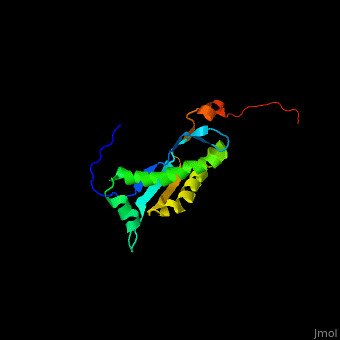Flotillins, also called reggie proteins, form a family of two ubiquitously expressed and highly conserved proteins, i.e., flotillin-1 and flotillin-2. Despite being products of different genes, both flotillins have a molecular weight of approximately 48 kDa and their sequences are quite similar (50% identity on mRNA level and 44% on protein level).
Flotillins are expressed in all mammals but they are also present in bacteria, plants, fungi and metazoans, but not in the budding yeast and C. elegant.
Flotillins are highly conserved among species. For example, mouse and human flotillin-1 share a 98.1% identical amino acid sequence. Even between vertebrates and invertebrates the similarity is more than 60%, implicating that flotillins are important for cell physiology.
Officially, flotillins belong to the group of SPFH domain containing proteins.
This SPFH (stomatin/prohibitin/flotillin/HflK/C) domain and a C-terminal “flotillin domain” comprising alanine and glutamic acid repeats are the only recognizable domains within the flotillin protein. The SPFH domain, also referred to as prohibitin homology (PHB) domain, was first identified in stomatin and is shared by several pro- and eukaryotic proteins. However, the function of the SPFH domain is still unknown. Most SPFH domain containing proteins tend to form oligomers, as was shown for stomatin, podocin, prohibitin and flotillins, although the SPFH domain does not mediate the oligomerization of flotillins. Another common feature of SPFH proteins is their association with lipid rafts. Typical with the SPFH domain containing proteins, flotillins also tend to form hetero- as well as homo-oligomers, but this oligomerization requires the flotillin domain and tyrosine residue 163 of flotillin-2. Flotillins stabilize each other, which became obvious upon siRNA mediated knockdown of either flotillin-1 or -2 and concomitant decrease in the expression of the other one. Notably, this interdependency is stronger in the case of flotillin-1, since flotillin-1 depletion typically results in only a moderate or even no depletion of flotillin-2, suggesting that flotillin-1 is more dependent on flotillin-2 than vice versa. Flotillins were originally believed to be transmembrane proteins that are enriched in caveolae which are a subtype of membrane rafts. However, this has been disputed in later studies where it was clearly shown that flotillins reside within non-caveolar rafts. In general, membrane rafts are defined as dynamic, nanoscale membrane microdomains enriched in cholesterol and glycosphingolipids, which function as sorting platforms for various cellular processes. Meanwhile, flotillins are
widely used as membrane raft marker proteins. In contrast to what was assumed originally, they do not traverse the membrane, but are attached to the cytosolic leaflet of the plasma membrane by means of fatty acid modifications and possibly hydrophobic stretches in the case of flotillin-1. Furthermore, flotillins harbor several putative, conserved phosphorylation sites , for some of which (i.e., Tyr160 for flotillin-1, Tyr163 for flotillin-2) a functional role has been shown. Flotillins are expressed ubiquitously, and their expression is particularly high in brain, heart, lung, and placenta, but fairly low in pancreas and liver. Despite their ubiquitous tissue distribution, the expression of flotillins underlies, at least to some extent, transcriptional regulation and can be fine-tuned by different transcription factors.
Function
Flotillins are highly conserved proteins that localize into specific cholesterol rich microdomains in cellular membranes. They have been shown to be associated with, for example, various signaling pathways, cell adhesion, membrane trafficking and axonal growth. Recent findings have revealed that flotillins are frequently over expressed in various types of human cancers.
Disease
Numerous studies have also shown that overexpression of flotillins is a feature exhibited by several types of cancers and in many cases correlates with the disease stage, prognosis and patient survival. This has raised interest in the possibility that flotillins might be good targets for cancer therapy approaches.
Relevance
Structural highlights
References
1. Banning A, Kurrle N, Meister M and Tikkanen R, Flotillins in Receptor Tyrosine Kinase Signaling and Cancer. Cells. 2014 Feb 19;3(1):129-49.

